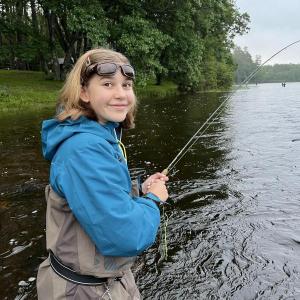Maine 4-H'er wins national AI challenge with fish-friendly culvert chatbot
When people think of artificial intelligence and conservation, they don’t always imagine the two intersecting. But for one Kennebec County 4-H member, the overlap has opened doors to innovation and earned national recognition. This summer, Morgan B, a member of the Delta Prime Robotics 4-H Club, won a national 4-H AI Community Challenge competition. Her project, the Fish-Friendly Culvert AI Chatbot, ties together the seemingly disparate worlds of conservation and technology, offering a potential solution for one of Maine’s long-standing infrastructure and environmental challenges: poorly designed culverts.
Bridging Conservation and Technology
Culverts may seem like a minor detail in the landscape, but they play an outsized role in both community safety and ecological health. Across Maine, undersized or improperly installed culverts cause flooding, road washouts and costly repairs. They also block fish passage, fragmenting critical coldwater habitats needed by salmonids and Maine’s cherished wild brook trout.
Morgan’s project uses artificial intelligence to help landowners identify problem culverts and find solutions that benefit both people and fish. By uploading inlet and outlet photos of their culvert, landowners can receive an AI-generated assessment that highlights structural issues, identifies permitting needs and even connects them with potential grants to cover replacement costs.
“I wanted to choose a project that had a widespread impact,” Morgan explained. “Culvert replacement isn't just for fish, it reduces flooding and road washouts and creates healthier communities. This solution is scalable, user-friendly and educational. An AI Chatbot could give immediate, personalized help and up-to-date information.”
From Concept to Prototype
To ensure the chatbot would deliver accurate, relevant information, Morgan consulted with experts in the field. She shared her early prototype with Matthew Streeter, president of the Sebago chapter of Trout Unlimited, who has worked in habitat connectivity and coldwater conservation for more than a decade. Streeter confirmed that the AI-generated assessments were factually correct, validating the project’s potential as a real-world resource.
The chatbot, affectionately named “Cully,” guides users through a friendly conversation. After requesting basic information like location and stream width, Cully analyzes culvert photos to flag issues such as perched outlets, undersized pipes and flow restrictions. It then provides recommendations for replacement options—like bottomless arch culverts or bridges that mimic natural stream conditions—and funding opportunities through state, federal and nonprofit programs.
A Youth Perspective on AI
As part of the 4-H AI Community Challenge, Morgan learned new skills in machine learning and data analysis while gaining a deeper understanding of how AI works. For example, she learned about retrieval-augmented generation (RAG) databases, which are systems that strengthen AI responses by connecting them to reliable data sources. She also discovered new ways AI can generate images and was inspired to learn that Mira Murati, former CTO of OpenAI, is a female leader now pioneering AI safety through her new venture, Thinking Machine Lab.
The competition also asked students to reflect on when it might be inappropriate to use AI. Morgan was clear-eyed in her answer: projects requiring human judgment or carrying risks of harm should not be delegated to machines. AI, she emphasized, should be a tool, not a substitute for creativity or responsibility.
The project is an example of how 4-H emphasizes hands-on learning, mentorship and leadership. By identifying a real problem in her community, working with an adult expert to validate her ideas and applying new technical skills to create a solution, Morgan experienced the full cycle of learning by doing. Along the way, she built confidence, practiced problem-solving and contributed meaningfully to conservation efforts. These outcomes are at the heart of 4-H’s mission to prepare young people for success in work and life. To learn more about the Maine 4-H program, visit the website at extension.umaine.edu/4h.
University of Maine Cooperative Extension
As a trusted resource for over 100 years, Extension has supported UMaine's land and sea grant public education role by conducting community-driven, research-based programs in every Maine county. UMaine Extension seeks to build thriving communities and help grow the food-based economy. Extension also leads Maine’s 4-H program, the most successful out-of-school youth educational program in the state. 4-H programs are grounded in the belief that kids learn best by doing and are developed to fit a variety of backgrounds, interests, budgets and schedules. Participants complete hands-on projects in areas like health, science, agriculture and civic engagement in a positive environment where they are encouraged to take on proactive leadership roles.




























